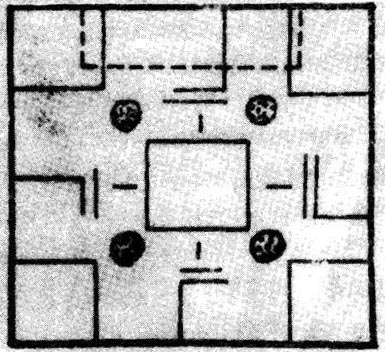Chapter 31 Section 1 Liubo Chess
Liubo chess is a kind of ancient chess game, which was very popular in the Spring and Autumn and Warring States and Qin and Han Dynasties.This kind of chess is played by two people, each with six pieces.Each of them has a chess piece that is equivalent to a king called "Xiao", and another five chess pieces that are equivalent to pawns are called "San".Chess is played on a board with curved lines, and the number of steps is determined by throwing chopsticks.
According to the research of modern chess historians, this ancient Liubo chess is actually the originator of all chess games with arms in the world, such as chess, chess, shogi, etc., are all played by Liubo. Chess gradually evolved and reformed.
The generation of Liubo chess may be before the Spring and Autumn Period and the Warring States Period. There is a passage in "Chu Ci·Calling the Soul" describing Liubo chess's shape and game method:
In the first sentence, it is said that the chess system of Liubo chess at that time was composed of three parts: chess, game and chopsticks.Chess is a pictographic chess piece that walks on the board, made of ivory, with six pieces on each side, one owl and five scattered, so it is called Liubo.The board is like a chessboard, square and with twists and turns.Chopsticks are dice.Made of bamboo, it is six cents long.The aristocrats used the jade as a decoration to show its preciousness.The chess pieces walk on the board, and the number of moves is determined by throwing chopsticks.
The second sentence is about the method of playing chess.Two people play a game or two groups of leagues, the method is "throw six chopsticks, play six chess".Throw the chopsticks first, then play chess, fighting wit and skill.When playing chess, we must pay attention to skills, attack and force each other, so as to make the opponent die.
The third sentence "Come into the owl and Mou, call Wubai more", it is said that at the critical moment in the end of the game, when throwing chopsticks and throwing "Wubai", you can kill the opponent's important chess pieces at will and win double victory (Mou). And burst out the cry of victory.
Yunmeng, Hubei once excavated ancient tombs at the end of the Warring States period, including Liubo chess games from the Warring States period.
The chessboard is made of wood, 38.5 centimeters long and 35 centimeters wide. The front of the chessboard is engraved with regular patterns and four dots are drawn with red lacquer.
The chess pieces are made of bone, and there are six pieces in total, all of which are rectangular.Among them, the red one is larger, three centimeters long, 1.4 centimeters wide and 1.8 centimeters high. This is Xiaoqi.The remaining five are smaller, black, 2.5 cm long, 1.2 cm wide, and 1.7 cm high. These are Sanzu.
There are six chopsticks, which are split into two halves by small bamboo tubes, forming an arc-shaped section, 19.5 cm long.
The shape and system of Liubo chess in the Qin and Western Han Dynasties is basically the same as that in the Spring and Autumn and Warring States Periods.

Liubo chess game map in the Warring States period
